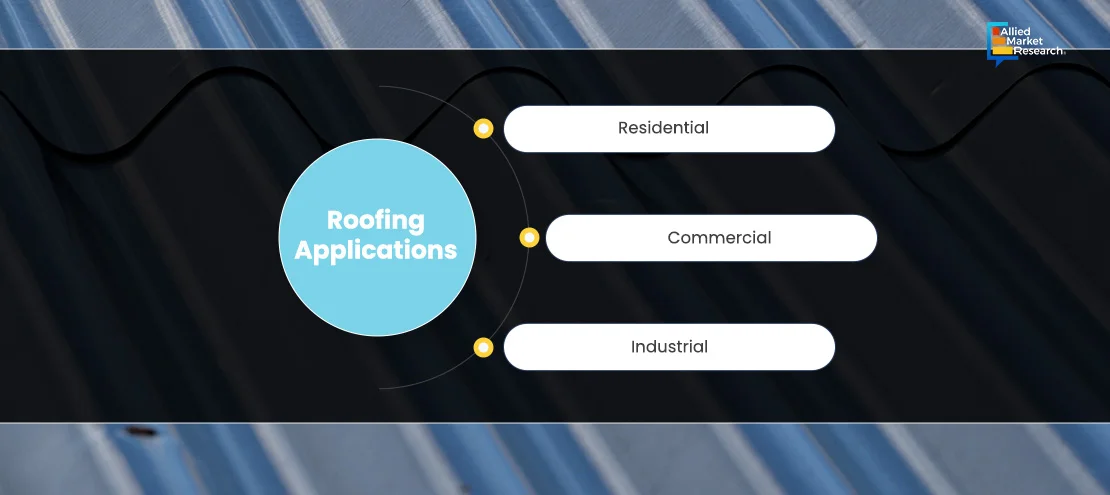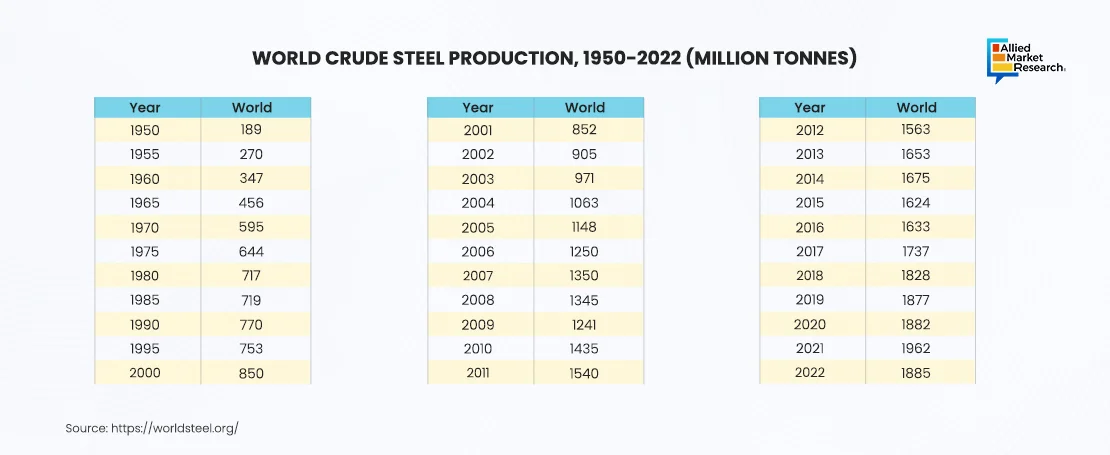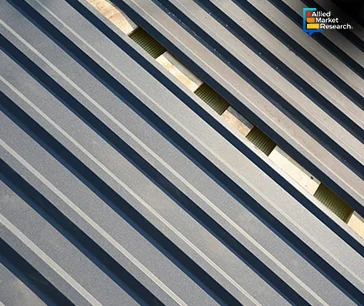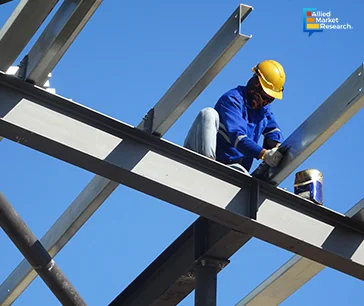Table Of Contents
- Supply Side Analysis
- Technological Advancements
- Enhanced Coatings and Finishes
- Cool Roof Technology
- Lightweight Steel Roofing Systems
- Sustainability and Environmental Impact
- Case Studies
- Innovative Application at GreenEco Buildings
- Efficiency Gains with QuickBuild Solutions
- Sustainable Innovations at EcoHomes LLC
- Sustainable Practices Fuelling Growth in the Landscape
- Winding up

Sonia Mutreja

Koyel Ghosh
Transforming Construction: Innovations in the Landscape of Steel Roofing

The roofing market, the parent market of steel roofing, encompasses a wide range of materials and applications designed to provide durability, protection, and aesthetic appeal to buildings. This market includes various types of roofing such as asphalt shingles, clay and concrete tiles, wood shakes, slate, and metal roofing, including steel. Roofing applications span residential, commercial, and industrial sectors. In residential settings, roofing materials enhance curb appeal and increase property value while providing weather resistance. Commercial buildings utilize roofing solutions to ensure energy efficiency, durability, and low maintenance. Industrial applications demand roofing systems that can withstand extreme conditions, support heavy loads, and offer long-term reliability. The roofing market is driven by technological advancements, such as cool roofs and green roofing systems, which contribute to energy savings and environmental sustainability. With a growing emphasis on building resilience and sustainability, the roofing market is expected to keep innovating and growing.
Out of the available roofing types, steel roofing has gained widespread acceptance due to its robustness, versatility, and sustainability. The global steel roofing market was valued at around $13-15 billion in 2023 and is projected to grow at a cCAGR of around 5% from 2024 to 2029. This expansion is driven by the surge in construction activities and the increasing adoption of eco-friendly building materials.

Supply Side Analysis
The below image depicts a historical overview of world steel production from 1950 to 2022 in million tonnes. The data is segmented into three columns, each listing the production figures for specific years. Starting at 189 million metric tons in 1950, steel production shows a steady increase over the decades, reaching significant milestones such as 456 million metric tons in 1965, 719 million metric tons in 1985, and 1,148 million metric tons in 2005. The trend keeps rising, reaching 1,885 million metric tons in 2022. This upward trajectory reflects the growing global demand for steel driven by industrialization, urbanization, and infrastructural development
Technological Advancements
Enhanced Coatings and Finishes
Recent innovations in coatings and finishes have significantly improved the performance of steel roofing. Advanced coatings like Galvalume and galvanized finishes enhance the resistance of steel roofs to corrosion and rust. For instance, BlueScope Steel introduced its next-generation COLORBOND steel with Activate technology in March 2023, promising up to 50% longer lifespan compared to traditional coatings. Similarly, AK Steel's ZINCGRIP GA steel, with a hot-dip galvanized finish, offers exceptional protection against corrosion while maintaining excellent surface quality for painting. Nucor Corporation has also developed a proprietary coating called COR-TEN, which forms a stable rust-like appearance after exposure to weather, providing long-term durability and an aesthetic appeal without the need for painting. Moreover, companies like Tata Steel have introduced their Durashine range of steel roofing with a unique metallic coating that enhances reflectivity, reducing heat absorption and improving energy efficiency. These advancements highlight the ongoing efforts within the industry to enhance the longevity, performance, and sustainability of steel roofing materials through innovative coating technologies.

Cool Roof Technology
Cool roof technology is revolutionizing the steel roofing industry. Reflective coatings are now being applied to steel roofs to reflect more sunlight and absorb less heat. In a 2022 study by the Cool Roof Rating Council, it was found that reflective steel roofs could reduce cooling energy use by up to 15%. Companies like CertainTeed have launched products like the CoolStar roofing system, which offers significant energy savings. Additionally, Owens Corning has introduced their Duration COOL shingles that integrate solar-reflecting granules to minimize heat absorption, contributing to lower cooling costs and enhanced comfort. Similarly, GAF's Cool Series Shingles feature innovative reflective technology that reflects solar energy, reducing the heat buildup in the attic and decreasing the demand for air conditioning. These advancements in cool roof technology are not only improving energy efficiency but also promoting sustainable building practices by reducing urban heat island effects and lowering greenhouse gas emissions.

Lightweight Steel Roofing Systems
The development of lightweight steel roofing systems has made installation quicker and more efficient. These systems reduce the overall structural load on buildings, making them ideal for both new constructions and retrofits. In April 2023, Tata Steel introduced their new lightweight steel roofing system, Durashine, which is 30% lighter than traditional steel roofs, significantly reducing installation time and costs. Similarly, Kingspan has launched their UltraLight Steel roofing panels, which not only lower the structural load but also enhance thermal performance, contributing to energy savings. Additionally, companies like Metroof have developed innovative lightweight steel roofing solutions that are easy to handle and install, reducing labor costs and project timelines. These advancements in lightweight steel roofing systems are streamlining construction processes and offering more versatile and cost-effective solutions for various building applications.
Sustainability and Environmental Impact
Steel roofing is an environmentally friendly option, contributing to sustainable building practices. Steel roofs are highly recyclable, with many containing up to 25-30% recycled materials. At the end of their long life, steel roofs can be fully recycled, reducing landfill waste. According to a 2023 report by the World Steel Association, the recycling rate for steel products in construction is over 85%.
Moreover, steel roofs can significantly improve a building's energy efficiency. By reflecting more sunlight and reducing heat absorption, steel roofs lower the demand for air conditioning. This reduction in energy use translates into lower greenhouse gas emissions, aligning with global sustainability goals. For example, a study by the U.S. Department of Energy in 2023 showed that buildings with reflective steel roofs experienced a 20% reduction in energy costs.
Case Studies
Innovative Application at GreenEco Buildings
GreenEco Buildings, a leader in sustainable construction, has embraced steel roofing across multiple projects to enhance energy efficiency and durability. By incorporating advanced cool roof technology, GreenEco Buildings has achieved significant energy savings, reducing cooling costs by up to 20%. This technology involves using reflective coatings that increase the solar reflectance of the roofs, thereby decreasing the amount of heat absorbed by the buildings.

One notable project is the EcoPark Office Complex, completed in June 2023. This state-of-the-art facility features steel roofing with high solar reflectance, which has substantially lowered the building's energy consumption. The steel roofs used in this project have also demonstrated exceptional durability, requiring minimal maintenance over time. The successful implementation at EcoPark highlights the dual benefits of cost savings and environmental sustainability achieved through the use of advanced steel roofing materials. GreenEco Buildings' commitment to integrating sustainable practices into their projects sets a benchmark for other companies in the construction industry.
Efficiency Gains with QuickBuild Solutions
QuickBuild Solutions, a construction firm renowned for its rapid deployment structures, has integrated lightweight steel roofing systems to improve efficiency and project outcomes. These roofing systems are designed to be 30% lighter than traditional steel roofs, which has significantly reduced installation times. As a result, QuickBuild Solutions has been able to complete projects ahead of schedule, leading to increased customer satisfaction and operational efficiency.
In March 2024, QuickBuild Solutions reported a remarkable 25% increase in project completion rates due to the adoption of lightweight steel roofing systems. This efficiency gain has not only allowed them to handle more projects simultaneously but has also improved the overall structural integrity and safety of their buildings. The lightweight nature of these roofs minimizes the load on building structures, making them ideal for both new constructions and retrofits. The company's strategic use of advanced steel roofing technologies underscores their commitment to innovation and excellence in the construction industry.
Sustainable Innovations at EcoHomes LLC
EcoHomes LLC, a prominent developer of eco-friendly residential communities, has leveraged steel roofing to enhance the sustainability and energy efficiency of its housing projects. By utilizing recycled steel materials, EcoHomes LLC has been able to create roofing solutions that are not only durable but also environmentally friendly. The use of recycled materials aligns with the company's mission to reduce the environmental impact of its construction activities.
In October 2023, EcoHomes LLC completed the GreenValley Housing Development, a community of 150 homes featuring steel roofing made from 25% recycled materials. These roofs have been designed with cool roof technology, reflecting more sunlight and reducing heat absorption. This feature has led to a 15% reduction in energy costs for homeowners, as reported in a post-occupancy survey conducted in January 2024. The steel roofs in GreenValley have also proven to be highly durable, withstanding harsh weather conditions with minimal maintenance required.
EcoHomes LLC's innovative use of steel roofing not only demonstrates the potential for significant energy savings and sustainability in residential construction but also sets a new standard for environmentally conscious building practices. Their commitment to using advanced materials and technologies highlights the important role of sustainable construction in addressing global environmental challenges.
Sustainable Practices Fuelling Growth in the Landscape
The steel roofing market is experiencing significant growth driven by technological advancements and increasing awareness of sustainable building practices. Innovations such as 3D printing and robotic assembly are reshaping the industry landscape, allowing companies to produce components with higher precision and streamline manufacturing processes. For example, SteelFab is utilizing 3D printing technology to create intricate steel roofing components, while SteelTech's development of a robotic assembly line aims to reduce manufacturing costs by 20%.
Emerging markets, particularly in Asia-Pacific and Latin America, are driving demand for steel roofing due to rapid urbanization and infrastructure development. For instance, in 2023, construction activities in China accounted for 28% of global construction, boosting the demand for steel roofing materials. Similarly, India's construction sector is growing at an annual rate of 8%, driving the need for durable roofing solutions. ArcelorMittal's expansion in Brazil reflects efforts to meet the growing demand in Latin America, where the construction sector is projected to grow by 3.9% annually from 2022 to 2027.
The emphasis on sustainable construction practices is boosting the adoption of steel roofing globally. Green building certifications such as LEED are influencing purchasing decisions, with many new commercial buildings opting for steel roofing for its sustainability benefits. According to a survey by the Green Building Council, in 2023, 60% of new commercial buildings in the U.S. were LEED certified, with steel roofing being a preferred choice for 45% of these projects.
Winding up
The steel roofing market is evolving rapidly, supported by technological advancements and a growing emphasis on sustainability. Enhanced coatings, cool roof technology, and lightweight systems are among the key innovations driving the growth. As the market grows, steel roofing remains a durable, efficient, and eco-friendly option for many construction uses. By adopting these innovations, the steel roofing industry is set to meet modern building demands and support a sustainable future.
Allied Market Research serves as a trusted partner for vendors in the steel roofing market, offering in-depth insights and customized strategies to capitalize on steel roofing technologies across various sectors, including residential, commercial, public infrastructure, educational institutions, and industrial applications. With AMR's expertise, businesses can gain the knowledge and tools necessary to identify opportunities, evaluate market demand, and drive innovation in steel roofing solutions. By exploring AMR's comprehensive analysis, businesses can access valuable information about leading steel roofing manufacturers, their strategies, and key industry developments. To learn more about the latest technologies, innovations, and market dynamics in the steel roofing industry, contact our specialists today!

